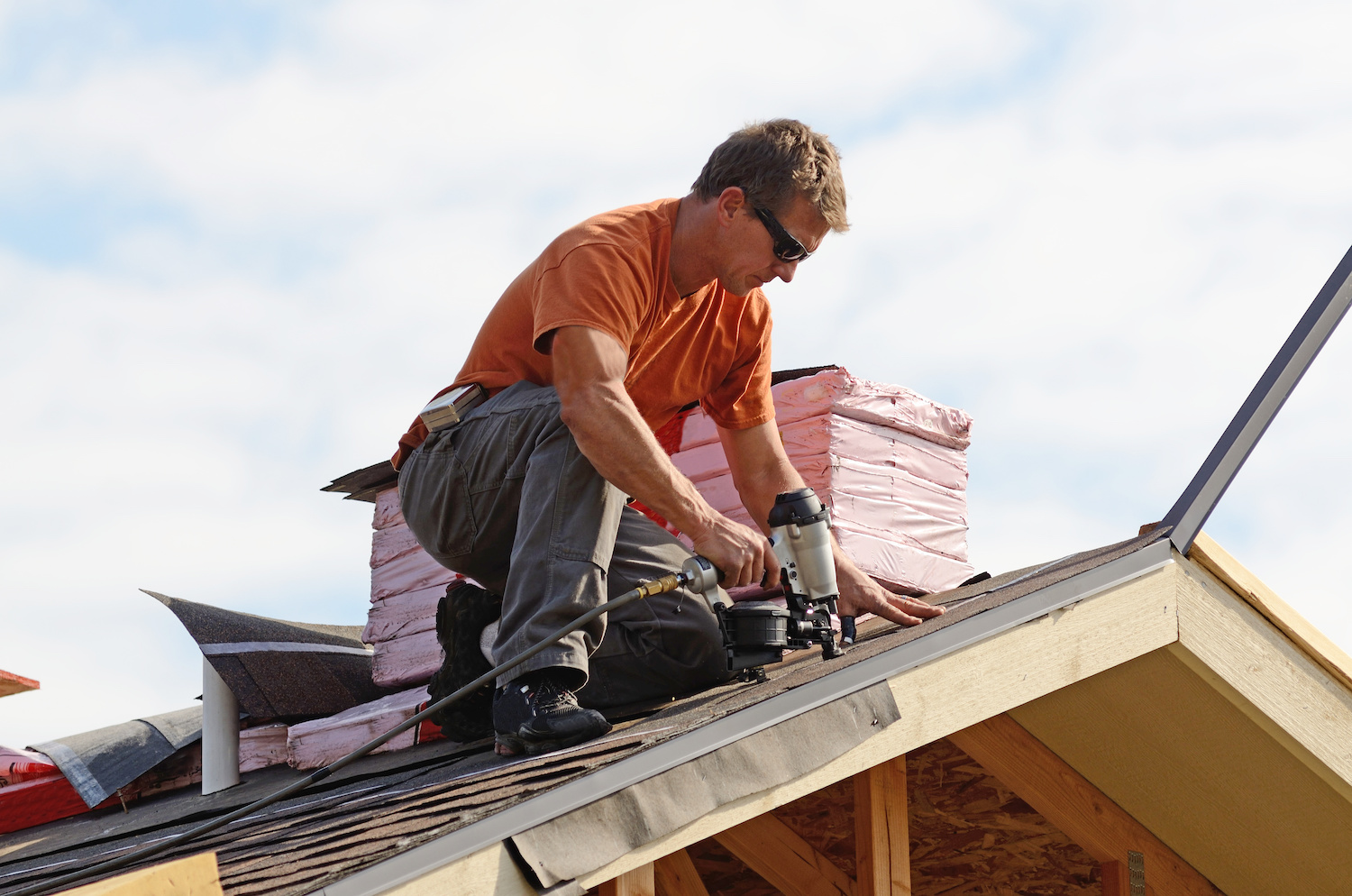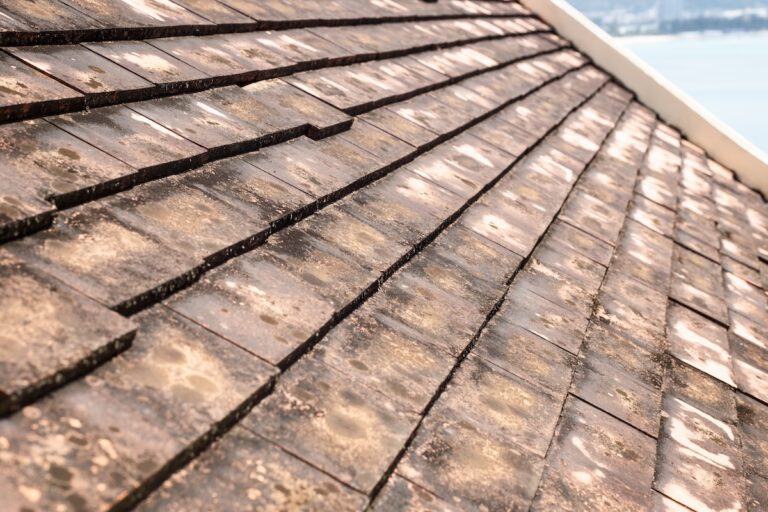There are many roofing tools a roofer can choose from. Certain machinery and accessories help get the job done faster. Completing roofing work on your home can require different tools and methods depending on the contractors and the location of the job.
When it comes to roofing, having the right tools can make all the difference between a smooth, efficient project and a frustrating, time-consuming ordeal. Whether you’re a seasoned professional or a DIY enthusiast, equipping yourself with the best roofing tools is essential for ensuring quality craftsmanship, safety, and efficiency. In this blog post, we’ll explore:
- The must-have tools that every roofer should consider adding to their toolkit
- Essential hand tools
- Innovative power tools that can elevate your roofing game to the next level
Let’s get started and gear up for success!
Top Roofing Tools to Make Your Roofing Project Easier
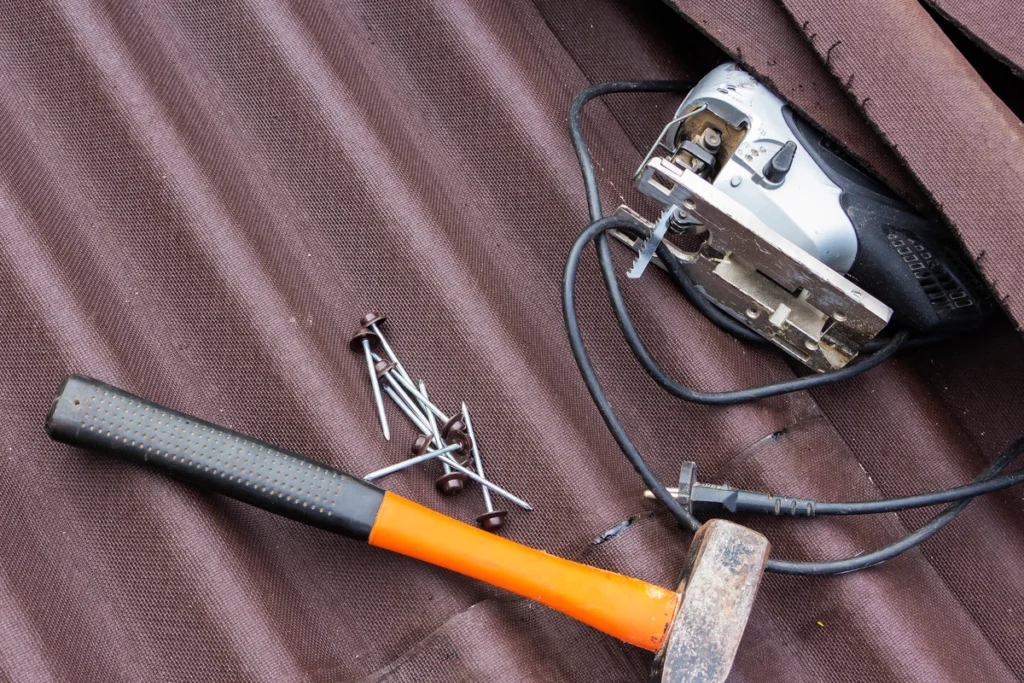
Want to work like a roofing pro? Here are the steps you need to take!
Ladders
Ladders come in all forms and styles. Some roofs require extendable ladders, while others can be accessed with simple traditional ladders. Thanks to redesigns, ladders are much safer today. You can find them with hooks and stabilizers to secure the tool against the building for extra safety. Ladders get the job done as you can’t climb to the roof without them.
Tarps
Tarps are a great way to minimize the mess below the roof. When tearing asphalt shingles and other materials apart, pieces fall to the ground. If you lay a tarp on the ground at the base of the building, the tarp can be used to pick them up in one single scoop.
Wheelbarrow
Wheelbarrows allow workers to move roofing hatchets, a roofing shovel, an air compressor, and other roofing tools and materials, including other roofing materials, around the job site. Although wheelbarrows have three wheels and require human labor and balance to work them, they are reliable. Wheelbarrows make roofing jobs simpler, especially when transferring shingles in large quantities.
Tool Belt
A tool belt keeps your small roofing tools organized and at easy access. A tool belt will allow roofers to keep their tape measure, knife, chalk, and other small tools on their waste at all times.
Non-slip Shoes
Shoes with extra grip or additional grooves in the soles will help roofers maintain a stable balance on steep roof inclines. Roofers are prone to falling due to steep angles while working. It is essential to choose the right shoes or boots for the job.
Hammer Tacker
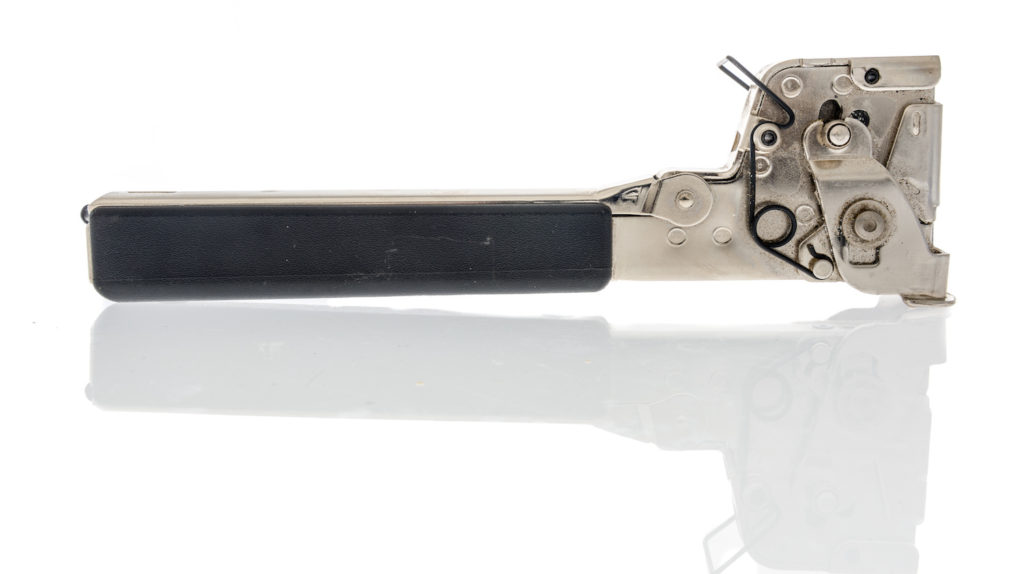
A hammer tacker is equivalent to an office stapler, except bigger and stronger. It is one of the best roofing tools allowing roofers to bind shingles together and stay attached to the wood framing of the building.
Shingle Removal Shovel
Shingle shovels are very handy when removing nails and shingles at once. These tools allow roofers to remove and push shingles off the roof in one single go.
Roofing Nail Gun
Roofing nail guns allow roofers to attach shingles to the roof faster than ever. Using galvanized roofing nails with a traditional hammer can be tedious and slow the job down. Roofing nail guns are high-powered and designed to speed up a job while retaining accuracy.
Roofing Utility Knife
Placing a roofing utility knife in the tool belt will provide the roofer with a quick option of adjusting shingle measurements and sizes. The knife is destined to cut through shingles with ease.
Pry Bar/Crowbar
Pry bars or crowbars become of great use when those stubborn shingles or nails just won’t budge. The tool allows roofers to drive a little extra force under the materials, removing them quicker and easier.
Measuring Tape
A measuring tape is a handy tool for all roofers. Having retractable tape on your side will provide for quick measurements and create a hassle-free job. The tape measure is an important tool to have by your side for any roofing task.
Roofing Hammer
A roofing hammer will come in handy when the nail gun doesn’t push a nail down. Sometimes a nail goes in at the wrong angles or encounters knots in the wood. Keeping a hammer by your side will allow for an extra tap to secure those shingles, making it an essential tool for various roofing tasks.
Roofing Wireless Drill
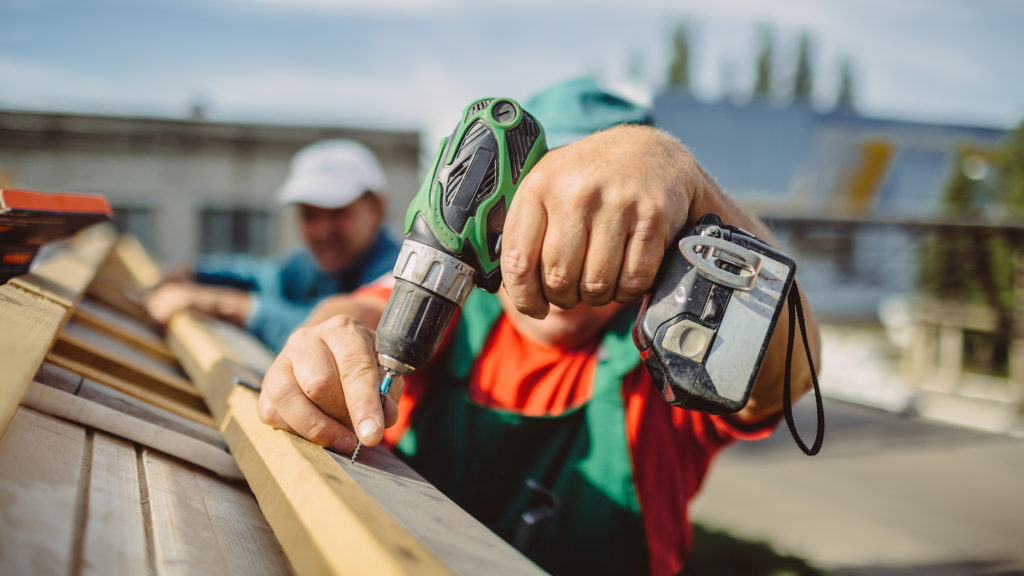
Running cords from the ground to the roof can be a hazard, tangling you up along the way. Having access to a wireless drill allows roofers to perform a job tangle-free. Wireless machinery increases the safety of workers when installing roofing supplies.
Chalk Line Tool
Chalk lines are the perfect roofing tool for helping roofers align new shingles properly without leaving a permanent mark of measurements. Chalk lines use chalk dust to mark measurements and guide shingles to the right spot. The good news is that the chalk will wash away quickly with water or rain once the work is complete.
Caulking Gun
Depending on the roofing material used, caulking guns are an essential tool for sticking the material to the roof frame. In some regions, roofers specialize in installing metal, wood, clay, and concrete to roofs that require heavy-duty binding materials. Caulk also prevents leaks in the roof.
Tin Snips
Tin snips help roofers cut through thin tin materials. This tool is handy for roofers completing tasks near the edge of the roof or gutters. They provide a cleaner finish to the area.
Air Knife
An air knife can be attached to an air compressor to make the cutting of shingles much easier. Sometimes it is not necessary to use air with the tool. This tool provides roofers with a fast action of shaping the shingles.
Magnetic Sweeper
A magnetic sweeper cuts the time spent looking for dropped material, such as roofing nails. At the end of the job, during the cleanup, roofers will roll the hand machine along the base of the building to pick up any dropped nails or small metal supplies.
Roofing Hatchet
The roofing hatchet is a multi-tool, allowing roofers to complete multiple tasks with one tool. This tool removes nails, lifts shingles, and pounds in any uplifted nails. It is a great tool to add to the tool belt.
Hard Hats
Roofing job sites can be dangerous, making the use of personal protective equipment essential. Roofers frequently opt for hard hats to protect themselves from falling debris. Roofing jobs often require roofers to work at many levels simultaneously, creating the chance for falling material to injure a worker. They provide extra safety and protect against unruly sunburns on the head when on the roof.
DIY Roofing Dos and Don’ts
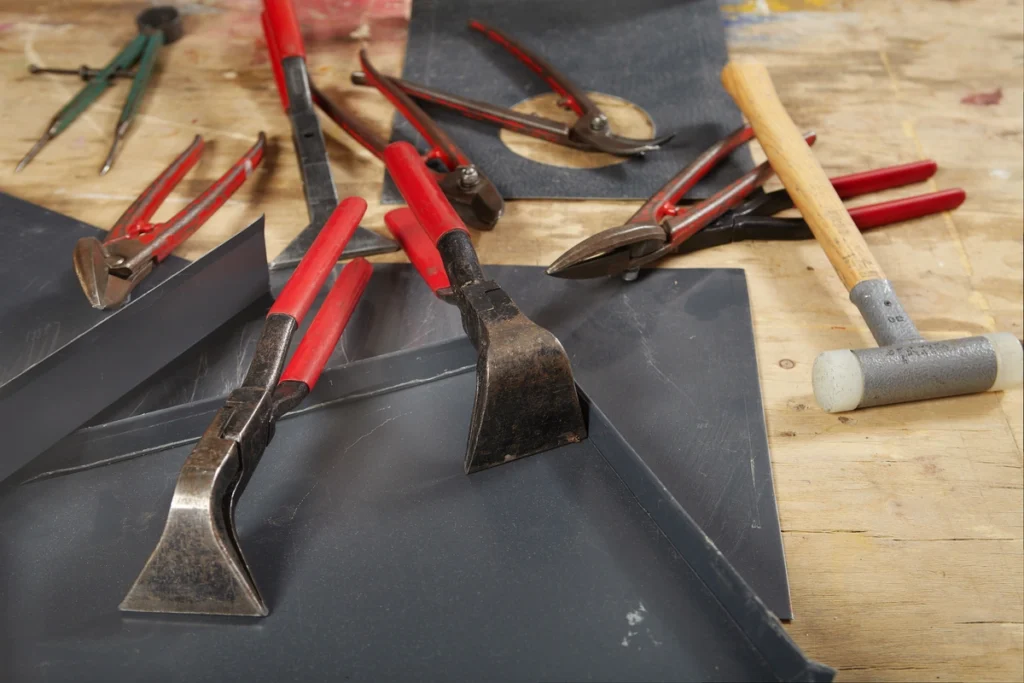
Taking on a roofing project by yourself can be both rewarding and cost-effective, but it’s crucial to approach it with careful preparation and awareness. Here are some essential dos and don’ts to guide you through your DIY roofing journey:
Dos:
- Do conduct thorough research and planning: Before starting, gather information about the roofing materials, methods, and tools you’ll need. A well-thought-out plan can save time and prevent potential issues. Having the right tools and knowledge, similar to a professional roofing company, is crucial for success.
- Do prioritize safety: Always wear appropriate safety gear, such as a helmet, gloves, and non-slip footwear. Use a harness and secure your ladder properly to minimize the risk of falls.
- Do check the weather forecast: Plan your project for a stretch of dry weather. Working in wet or windy conditions can be dangerous and can compromise the quality of your work.
- Do inspect your roof and structure: Check for any underlying damage or structural issues before installing new materials. Repair any problems to ensure a solid foundation for your new roof.
- Do seek assistance when needed: Roofing can be labor-intensive and having an extra set of hands can make the process smoother and safer. Don’t hesitate to ask for help from friends, family, or even a professional for critical tasks.
Don’ts:
- Don’t underestimate the complexity: Roofing can be more complicated than it seems. Avoid taking shortcuts and follow professional guidelines for each step to ensure a durable and high-quality finish.
- Don’t neglect local building codes: Ensure your project complies with local regulations and building codes. Non-compliance can lead to fines or having to redo the work.
- Don’t proceed without proper permits: Some areas require permits for roofing work. Check with local authorities and obtain the necessary permits before you begin.
- Don’t use inappropriate or subpar materials: Invest in quality materials that are suitable for your specific roofing needs to ensure longevity and durability.
- Don’t ignore your own limitations: Know your limits and recognize when a task is beyond your skill level. It’s better to hire a professional for complex or dangerous jobs than to risk your safety and the integrity of your roof.
By following these dos and don’ts, you can approach your DIY roofing project with confidence and set yourself up for a successful outcome. Happy roofing!
Choose the Right Tools for Your Roof
It is highly advisable to have the right tools for the job. Having more tools is always better than not having enough. When performing roofing, pros opt for the best roofing tools to make the job efficient and provide top-notch results.
Do you have a roofing job to complete? If so, you should consider these top 20 recommended tools from roofer professionals.
